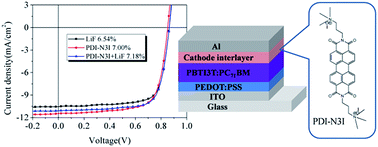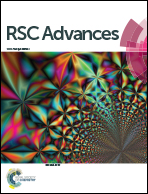New PDI-based small-molecule cathode interlayer material with strong electron extracting ability for polymer solar cells†
Abstract
A water-soluble small-molecule perylene diimide derivative functionalized with a propylenetrimethylammonium end group, namely N,N-bis(propylenetrimethyl ammonium)-3,4,9,10-perylenediimide (PDI-N3I), was synthesized and successfully applied to conventional polymer solar cells as the cathode interlayer firstly. The small-molecule PDI-N3I showed excellent solubility in water and a desirable LUMO energy level of −4.09 eV which matches well with that of PC71BM. With incorporation of the PDI-N3I cathode interlayer, a PDI-N3I/Al device exhibited a higher PCE of 7.00% than that (6.54%) of a LiF/Al device resulting from the improved short current density from 10.41 mA cm−2 to 11.44 mA cm−2, which benefitted from the more efficient electron extracting ability of PDI-N3I compared with LiF proved by photoluminescence quenching experiment. The high vertical conductivity of PDI-N3I endows it with the outstanding property of thickness insensitivity, which is compatible with roll-to-roll production. Additionally, device performance was further improved by the use of a PDI-N3I/LiF bilayered cathode interlayer and the highest PCE of 7.18% was achieved. This work provides a novel solution-processed cathode interlayer material which could effectively improve the efficiency of polymer solar cells.


 Please wait while we load your content...
Please wait while we load your content...